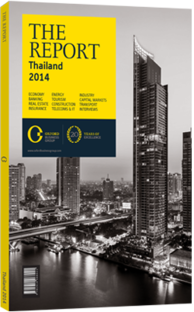Staying solid in a lean market: Banks are making provisions to deal with bad debt
Lenders in Thailand are expected to adopt a cautious position throughout 2014, keeping a close watch on household debt levels and monitoring the local economy’s return to growth following a contraction earlier in 2013. In late October 2013, Moody’s Investors Service issued a report on the outlook of the Thai banking system, saying that the sector remained stable, with loan-to-deposit ratios forecast to stay well below 100%, and capitalisation above regulatory minimums.
According to Simon Chen, an assistant vice-president and analyst with the ratings agency, though Thailand’s economic growth has slowed, its banks are well-positioned to withstand potential asset-quality challenges thanks to their strong capitalisation levels and increased provisioning, with expectations that earnings would continue to be solid for the next year to 18 months.
Although the sector’s outlook is stable, there are some challenges ahead for Thailand’s banks, the report said. Foremost among these were expanding rates of household indebtedness and rising property prices, with bank exposure to residential mortgages and other household loans comprising 35% of their lending portfolios, up from 30% four years ago.
Moody’s is not the only international ratings agency to highlight the potential risk that consumer loans presents to Thai banks, with Standard & Poor’s (S&P) also striking a warning note in a recent report. Banks in Thailand, along with those in Malaysia, were the most vulnerable in Asia due to a deterioration in household debt, said the report, released on October 29, 2013. However, S&P does not foresee a major economic crisis in Thailand or elsewhere in the region as long as interest rates and unemployment levels remain low. The S&P note coincided with a downward revision in growth projections from the Bank of Thailand (BOT), the fourth time the central bank had done so in 2013.
Lending Tightened Up
Uncertainty over the state of the economy seems to have put a damper on banking activities. BOT data showed slower loan growth in the corporate and retail segments during September 2013, though this was offset by a sharp rise in loans provided to small and medium-sized enterprises, which climbed 14% month-on-month, Salinee Wangtal, assistant governor of the BOT, said in late October.
The overall slowdown was in part due to a reduction in domestic investment and a tightening up of lending criteria in response to higher levels of household debt, which stood at just under 80% of GDP as of the end of the second quarter, she said. This was up from 64% in March 2011, according to Moody’s.
The pace of lending growth among all but two of Thailand’s listed banks slowed in the first two quarters of 2013, falling from an average rate of 3.3% in the first quarter to 2% in the second and 1.8% in the three months ending September 30, according to the BOT.
The two exceptions were Krung Thai Bank, which had said it expected its loan growth to increase by 10% in 2013, and CIMB Thai Bank, which posted a 17.2% rise in lending over the first nine months of 2013, a result it attributed to retail demand, an area other lenders have found to be cooling.
Rising But Manageable
As of the end of September, the 11 banks listed on Thailand’s stock exchange held a combined $8.94bn worth of non-performing loans (NPLs), a 6% increase since the beginning of the year. While nine of the 11 banks recorded a rise in NPLs, BOT officials said the expansion was not a matter of significant concern, given that the system’s overall ratio is still relatively low. A mid-October 2013 report from the central bank said that Thailand’s lenders had loan loss provisions equivalent to 140% of NPLs, a level the BOT said was the highest in the world. Any increase in NPLs should only be modest, according to Suwan Tansathit, senior executive vice-president at Bangkok Bank, the country’s largest lender by assets.
Given a degree of economic uncertainty, banks are expected to remain cautious in the near future. However, with lenders well-capitalised and having made provisions for soured loans, the consensus appears to be that they are prepared to weather any bad debts.
You have reached the limit of premium articles you can view for free.
Choose from the options below to purchase print or digital editions of our Reports. You can also purchase a website subscription giving you unlimited access to all of our Reports online for 12 months.
If you have already purchased this Report or have a website subscription, please login to continue.

